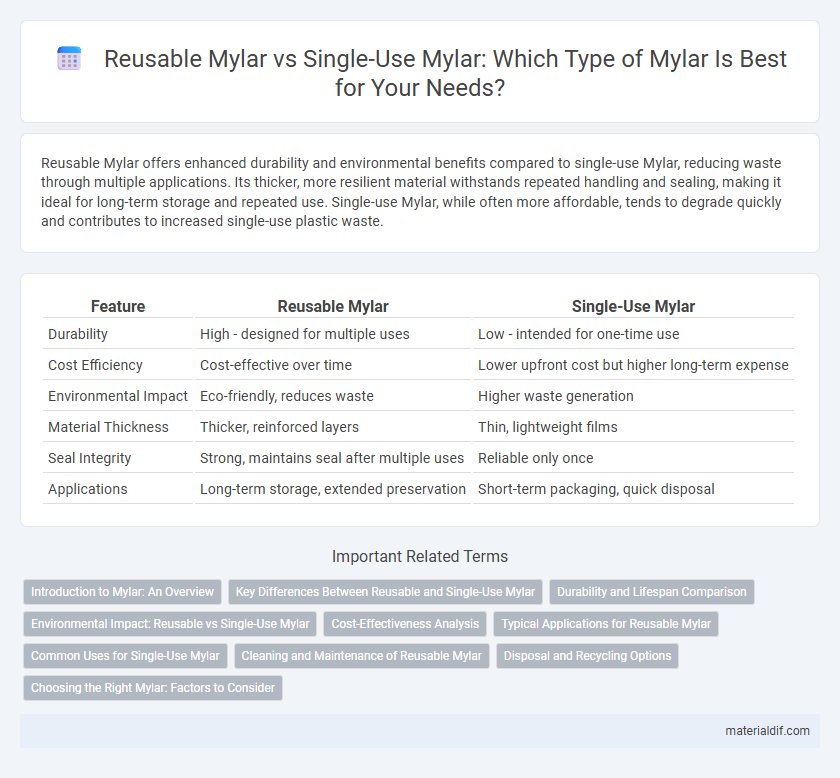Reusable Mylar offers enhanced durability and environmental benefits compared to single-use Mylar, reducing waste through multiple applications. Its thicker, more resilient material withstands repeated handling and sealing, making it ideal for long-term storage and repeated use. Single-use Mylar, while often more affordable, tends to degrade quickly and contributes to increased single-use plastic waste.
Table of Comparison
| Feature | Reusable Mylar | Single-Use Mylar |
|---|---|---|
| Durability | High - designed for multiple uses | Low - intended for one-time use |
| Cost Efficiency | Cost-effective over time | Lower upfront cost but higher long-term expense |
| Environmental Impact | Eco-friendly, reduces waste | Higher waste generation |
| Material Thickness | Thicker, reinforced layers | Thin, lightweight films |
| Seal Integrity | Strong, maintains seal after multiple uses | Reliable only once |
| Applications | Long-term storage, extended preservation | Short-term packaging, quick disposal |
Introduction to Mylar: An Overview
Mylar is a versatile polyester film known for its high tensile strength, chemical stability, and excellent barrier properties against moisture and gases. Reusable Mylar offers durability and long-term cost efficiency by maintaining its integrity through multiple uses, while single-use Mylar is typically thinner and optimized for disposable packaging applications. Both types leverage Mylar's unique characteristics, including dimensional stability and transparency, to meet diverse industrial and consumer needs.
Key Differences Between Reusable and Single-Use Mylar
Reusable Mylar offers enhanced durability through multiple layers of polyester film, making it ideal for long-term storage and environmental sustainability compared to single-use Mylar, which is thinner and designed for one-time applications. Key differences include the thickness and tensile strength, with reusable Mylar providing better resistance to punctures and moisture, ensuring prolonged preservation of contents like food or documents. Single-use Mylar is cost-effective for short-term needs but lacks the robustness and environmental benefits found in reusable variants.
Durability and Lifespan Comparison
Reusable Mylar exhibits superior durability due to its enhanced resistance to tearing, punctures, and environmental factors compared to single-use Mylar. Its extended lifespan supports multiple cycles of use without significant degradation in material integrity, making it ideal for applications requiring longevity and cost-efficiency. Single-use Mylar typically degrades faster under stress, limiting its suitability to short-term or disposable purposes.
Environmental Impact: Reusable vs Single-Use Mylar
Reusable Mylar significantly reduces environmental impact by minimizing waste and lowering resource consumption compared to single-use Mylar, which contributes extensively to landfill accumulation and pollution. Durable properties of reusable Mylar allow for multiple cycles of use, decreasing the frequency of production and disposal processes linked to carbon emissions. Choosing reusable Mylar supports sustainable packaging and storage solutions, aligning with eco-friendly practices that mitigate negative effects on ecosystems.
Cost-Effectiveness Analysis
Reusable Mylar offers significant cost savings over single-use Mylar by reducing material expenses through multiple cycles of use, lowering overall packaging costs in industries like food storage and electronics. The initial investment in durable, reusable Mylar is offset by decreased waste disposal fees and reduced frequency of repurchasing single-use materials. Companies report that adopting reusable Mylar can cut packaging costs by up to 40% annually while enhancing sustainability metrics, making it a financially and environmentally optimal choice.
Typical Applications for Reusable Mylar
Reusable Mylar is commonly used in applications such as durable packaging, protective covers for electronics, and insulated thermal blankets, where long-term use and resistance to tearing are essential. Unlike single-use Mylar, reusable variants are engineered to withstand repeated handling and environmental stress, making them ideal for industrial, agricultural, and event settings. These features optimize cost-efficiency and environmental sustainability in applications requiring repeated deployment.
Common Uses for Single-Use Mylar
Single-use Mylar is widely utilized for packaging perishable food items such as snacks, coffee, and pet food due to its excellent barrier properties against moisture, oxygen, and light. It is also commonly employed in medical applications for sterile packaging of instruments and pharmaceuticals. This disposable Mylar format ensures product freshness and sterility during transit and storage but is not designed for repeated use.
Cleaning and Maintenance of Reusable Mylar
Reusable Mylar requires regular cleaning and maintenance to preserve its reflective properties and durability, typically involving gentle washing with mild soap and water to remove dirt and residue without damaging the material. Proper drying and careful storage prevent mold growth and physical damage, extending the lifespan of reusable Mylar sheets. In contrast, single-use Mylar lacks these maintenance needs but may lead to higher environmental impact due to frequent disposal.
Disposal and Recycling Options
Reusable Mylar offers significant environmental benefits through its ability to be cleaned and repurposed multiple times, reducing waste and the demand for new materials. Single-use Mylar, while convenient, often ends up in landfills or incinerators due to limited recycling infrastructure and contamination issues. Effective disposal and recycling options for Mylar hinge on specialized facilities capable of processing polyethylene terephthalate-based films, emphasizing the need for improved waste management strategies to enhance Mylar's sustainability.
Choosing the Right Mylar: Factors to Consider
When choosing between reusable Mylar and single-use Mylar, consider durability, environmental impact, and cost-effectiveness. Reusable Mylar offers higher strength and long-term savings, making it ideal for frequent use and sustainable practices. Single-use Mylar suits short-term applications requiring lightweight packaging and lower initial investment.
Reusable Mylar vs Single-Use Mylar Infographic

 materialdif.com
materialdif.com